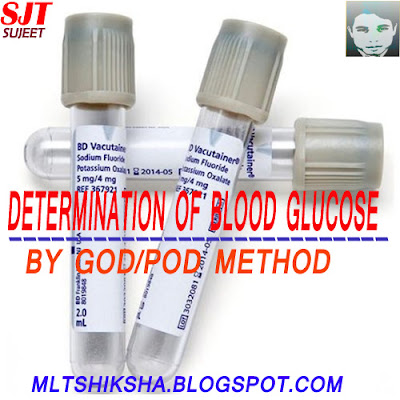Method –
Glucose Oxidase / Peroxidase
Principle –
जब Human Serum या Plasma में उपस्थित Aldehide
group के glucose का glucose oxidase नाम के enzyme द्वारा water और Oxygen की उपस्थिती में आक्सीकरण
होता है तब Gluconic Acid और hydrogen Peroxide बनता है-
Glucose + H2O + ½ O2 – Gluconic
Acid + H2O2
अब यही “Hydrogen Peroxide”, “4 Aminophenazone” और “Phenol” के साथ मिलकर “Peroxidase”
नामक Enzyme की सहायता द्वारा Pink colour
का compound, “Quinoneimine”
और “Water” बनाता है -
2 H2O2 + 4 Aminophenazone + Phenol – Quinoneimine + 4
H2O
अब इस Pink colour के compound को Spectrophotometer
या colorimeter
के
द्वारा Read कर ली जाती है।
Requirement -
- Glucose Reagent
- Serological Micropipette And Tip
- Test Tube or Cuvette
- Test Tube or Cuvette Stand
- Incubator
- Spectrophotometer or Colorimeter or Semi Autoanalyzer
 |
| Spectrophotometer |
Sample –
Fluoride Plasma या Serum.
Reagent –
- Buffer Enzyme (By mixing Glucoseoxidase 650units,
Peroxidase 500units, 4-aminophenazone 20mg, Sodium Azide 30mg into 100ml of
Phosphate buffer)
- Phenol Reagent
- Glucose standerd
Preparation Of Glucose Reagent –
1 part Phenol में 2 part Buffer/Enzymes Reagent Mix करने पर Glucose
Reagent तैयार हो जाता है। इसे 2-8 Degree centigrade पर Amber
colored Bottle में store करके रखते है।
Procedure –
- सबसे पहले Glucose Reagent को room Temp. पर कर लें।
- अब Labeled Test Tube या Cuvette में निम्नवत Pipetting करते है-
Glucose Reagent 1ml 1ml
1ml
Distilled Water 10µl - -
Glucose Standard - 10µl -
Plasma/Serum - -
10µl
- अब सभी Test Tube या Cuvette को अच्छी तरह
मिलाते है और 10 मिनट room temp. पर या 5 मिनट incubator में 37 Degree
centigrade पर Incubate करते हैं।
- अब मशीन पर 500nm-550nm Wave Length Set करते है और सबसे
पहले Blank की Absorbance को मापते है ।
- इसके बाद Blank के Against Standard की Absorbance को मापते है।
- अब Standard के Against Test की Absorbance को मापते है और
रीडिंग को नोट कर लेते है।
Calculation –
Plasma or Serum Glucose mg/dl
= O.D. of Test /O.D. of Standard ×100 mg/dl
OR
Plasma or Serum Glucose mg/dl
= O.D. of Test /O.D. of Standard × 5.55 mmol/L
Normal Values :-
- Fasting Blood Sugar – 70-110 mg/dl
- Post Prandial (P.P.) Blood Sugar – up to 140 mg/dl
- Random Blood Sugar – up to 150 mg/dl
! Thank you !
A Special Thanks to Vineet Dixit for Recommended this Post and Helping Me to Write This Post.













